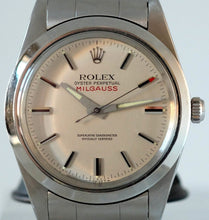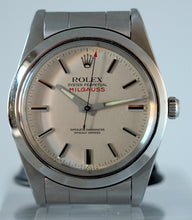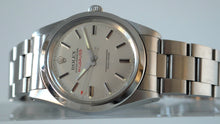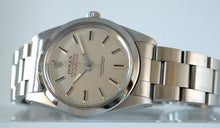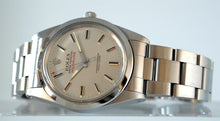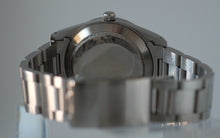
Rolex, Oyster Perpetual, "Milgauss", Ref. 1019. anti-magnetic, water-resistant, center seconds, self-winding, stainless steel Chronometer wristwatch.
Case: Three-body, polished and brushed, inclined bezel, soft iron gilt metal antimagnetic protecting cap forming a Faraday cage, screwed-down case back and crown.
Dial: Silvered over soft iron with steel baton indexes and luminous dots, outer minute/seconds divisions, "Milgauss" in red. Luminous tapered steel baton hands, red-tipped center seconds hand.
Movement: Cal. 1580, rhodium-plated, 26 jewels, straight-line lever escapement, monometallic balance adjusted to 5 positions and temperature, shock absorber, white metal Breguet balance spring, Microstella regulating screws.
Ref: 1019
Circa: 1970s
Diameter: 38mm Thickness: 13mm
More about Rolex:
The Rolex Day-Date model was launched at the Basel Fair in 1956, and has remained a reliable automatic, water-resistant wristwatch with a timeless design that has not changed much since its introduction more than 60 years ago. Featuring time, day, and date indication in a precious metal case, the Day-Date has everything one could want or need in a wristwatch if they had to choose just one.
The reference 1803 Day-Date was introduced in 1961, along with the references 1804 and 1806. The 1803 featured a case that was slightly smaller that previous references, and contained the new caliber 1555 movement.
In 1965, President Lyndon Johnson was photographed wearing a yellow gold Rolex Day-Date – although he was the second US President to wear a Rolex (Dwight Eisenhower being the first) he was the first to wear the Day-Date model with a particular bracelet style. In the mid-1960’s, Rolex began advertising the Day-Date as having the “Presidential” bracelet, designed for the Day-Date model. Later, in the 1980’s, Rolex began referring to the actual Day-Date model itself as the Rolex President in advertisements.
The present example of the Day-Date President is in New Old Stock condition, with a factory plastic protection and reference sticker on the back. The watch with its deep blue dial is striking. A remarkable bargain on a "Time Capsule" watch which has never been worn.
More about Rolex:
In the 1950s, Rolex was approached by CERN (the Conseil Europeen pour la Recherche Nucléaire) to develop a wristwatch that could be exposed to strong magnetic fields and still function. At the time, anti-magnetic wristwatches existed, but none could withstand the strength of the magnetic fields at CERN, which were up to 70,000 amperes/meter – 1,000 gauss (or mille gauss). At such an intense level of electromagnetic energy, the movement of most watches would simply stop running - a normal watch could only withstand between 70 and 90 Gauss.
Rolex developed an anti-magnetic watch for physicists using the principle of a “Faraday Cage”. This particular development came from physicist Michael Faraday, who in 1863 built a room that was coated with metal foil. He then produced high-voltage discharges against the outside of the room, and used an electroscope to measure the electrical charge on the inside of the room. The metal foil prevented any excessive charges from entering the room. Rolex used this principle to place the watch movement in an iron inner case, thus protecting it from magnetic fields. The resulting anti-magnetic watch was the Milgauss reference 6541.
In 1966, Rolex redesigned the Milgauss and launched the reference 1019. Unlike the 6541, it featured a blank polished bezel, and was available with either a silvered dial or a black dial. The 1019 model also featured a newer movement, the caliber 1580. The model was produced through 1990, and was only available in stainless steel.
The Milgauss model is appreciated by collectors for being the last Rolex “tool” watch designed for a specific activity and for use by a specific group of clients. Nevertheless, it’s simplistic design and functionality is what makes it so appealing today. The present watch is a mint example of this celebrated and sought-after Milgauss reference.









